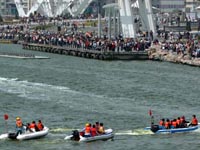
Travel agents, restaurants owners and even souvenir peddlers are happily counting revenues brought by heaps of nationwide tourists during the May Day holiday last week.
While some went sightseeing, shopping or eating, others made efforts to keep fit, read or watch TV. Yet, others slumbered away the seven-day holiday.
Official statistics show that more than 100 million trips were taken during the holiday week that ended on Friday. Travelers spent up to 39 billion yuan (US$4.7 billion), up 17 percent compared with the same period in 2002.
Since 2001, the government has moved to give people more leisure time to spur domestic consumption.
Now Chinese people enjoy three seven-day holidays every year around the May Day, National Day and Spring Festival.
Last year the outbreak of SARS, forced the central government to cancel the holiday week for spring.
According to the office for nationwide tourism co-ordination, nearly 30 percent of China's urban population chose travel for recreation during the holiday week.
To transport the tourists, roads and rails played an important role. According to officials with the Ministry of Communications, about 310 million people used public transportation in the seven days, 9 percent more than in 2002.
Also, more and more people chose to travel with their own vehicles.
"Traffic was smooth when I drove from Beijing to the Beidaihe summer resort in Hebei Province," said a female tourist surnamed Guo.
Apart from traveling, recreational activities also included "keep-fit" exercising at the gym, swimming, tennis and playing table tennis.
Doing physical exercises really embodied the significance of holidays, said a middle-aged man surnamed Liang who became a gym club member at the Beijing Scite Keep-fit Centre in the week.
Liang designed an exercise agenda for the holiday, in which he played tennis for an hour and a half on each of the seven days.
Shopping was another major activity which helped boost the holiday economy.
In Beijing alone, retail sales during the holiday week were estimated at 7 billion yuan (US$843.37 million), and sales income of business enterprises in the city, at 1.11 billion yuan (US$133.73 million).
Hong Kong tourism boomed
During the holiday, about 400,000 Chinese mainland tourists visited Hong Kong, yielding about 2.3 billion yuan (US$277 million) in revenues.
"Chinese mainland tourists have become a dynamic consumption force in the Hong Kong retail market, with the extension of the Individual Visit Scheme in more Chinese mainland cities," said Yu Pang-chun, Director of Hong Kong Retail Management Association (HKRMA).
Yu said, triggered by the Individual Visit Scheme and the gradual growth of the local economy, Hong Kong's consumption market is expected to witness a full scale recovery in the second half of this year.
Statistics indicate that local consumers contributed to four fifth of the overall retail business volume in Hong Kong. Tourists contributed one fifth and Chinese mainland tourists' consumption volume accounts for about 70 percent of the tourists' consumption volume.
He said, Chinese mainland tourists usually buy digital cameras, cosmetic and jewelry products in downtown areas or tourism spots in Hong Kong.
Disasters
But the holiday was not completely rosy, with several disasters and accidents reported.
More than 70 people were injured when two vessels collided Saturday evening on the Yangtze River near the Chongqing Municipality in Southwest China.
No deaths or missing people had yet been reported, an official said yesterday. The crash occurred at 8:20 pm Saturday between a passenger ship and an oil tanker some 2 kilometers away from the Chuanwei Wharf in Changshou District of Chongqing.
In addition, rescuers are still continuing their efforts to find 15 miners who were trapped for more than one week in a flooded coal mine in Wuhai city, North China's Inner Mongolia Autonomous Region, as hope fades for them to be found alive.
Thirty-two miners were working underground when the accident occurred.
(China Daily May 10, 2004)
|

